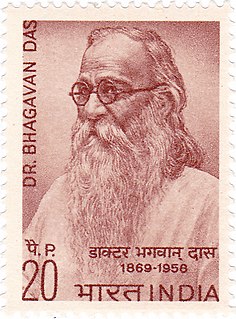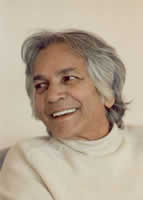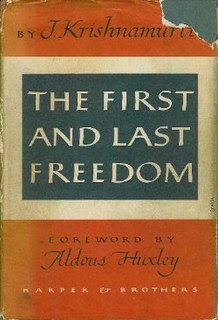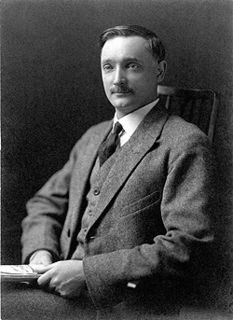
Jiddu Krishnamurti was an Indian philosopher, speaker and writer. In his early life he was groomed to be the new World Teacher but later rejected this mantle and withdrew from the Theosophy organization behind it. His interests included psychological revolution, the nature of mind, meditation, inquiry, human relationships, and bringing about radical change in society. He stressed the need for a revolution in the psyche of every human being and emphasised that such revolution cannot be brought about by any external entity, be it religious, political, or social.

The Theosophy Society – Adyar is the name of a section of the Theosophical Society founded by Helena Petrovna Blavatsky and others in 1882. In that same year, its headquarters moved with Blavatsky and president Henry Steel Olcott from New York to Adyar, an area of Chennai, India. The designation 'Adyar' is added to make it clear that this is the Theosophical Society headquartered there, after the American section and some other lodges separated from it in 1895, under William Quan Judge.

The Theosophical Society, founded in 1875, is a worldwide body with aim to advance the ideas of Theosophy in continuation of previous Theosophists, especially that of the Greek and Alexandrian Neo-Platonic philosophers dating back to 3rd century AD. It also encompasses wider religious philosophies like Vedānta, Mahāyāna Buddhism, Qabbalah, and Sufism. The Theosophical Society functions as a bridge between East and West, emphasizing the commonality of human culture.

Annie Besant was a British socialist, theosophist, women's rights activist, writer, orator, educationist, and philanthropist. Regarded as a champion of human freedom, she was an ardent supporter of both Irish and Indian self-rule. She was a prolific author with over three hundred books and pamphlets to her credit. As an educationist, her contributions included the founding of the Banaras Hindu University.

Bhagwan Das was an Indian Theosophist and public figure. For a time he served in the Central Legislative Assembly of British India. He became allied with the Hindustani Culture Society and was active in opposing rioting as a form of protest. As an advocate for national freedom from the British rule, he was often in danger of reprisals from the Colonial government. He was awarded the Bharat Ratna in 1955.

Uppaluri Gopala Krishnamurti, known as U. G. Krishnamurti, or just U.G., was an Indian speaker who questioned the state of enlightenment. Although many considered him an "enlightened" person, U.G. often referred to his state of being as the "natural state". He claimed that the desire for the experience of enlightenment only takes one further away from one’s natural state, and that the search for enlightenment is essentially a neurotic search for permanent pleasure and happiness.

Balmoral is an urban locality in the suburb of Mosman in Sydney, New South Wales, Australia. It is in the local government area of the Municipality of Mosman and is part of the Lower North Shore.

George Sidney Arundale was a Theosophist, Freemason, president of the Theosophical Society Adyar and A bishop of the Liberal Catholic Church. He was the husband of the celebrated Indian dancer Rukmini Devi Arundale.

Radha Burnier was born in Adyar, India. She was president of the Theosophical Society Adyar from 1980 until her death in 2013. She was General Secretary of the Indian Section of the Society between 1960 and 1978, and was previously an actress in Indian films and Jean Renoir's The River.

The First and Last Freedom is a book by 20th-century Indian philosopher Jiddu Krishnamurti (1895–1986). Originally published 1954 with a comprehensive foreword by Aldous Huxley, it was instrumental in broadening Krishnamurti's audience and exposing his ideas. It was one of the first Krishnamurti titles in the world of mainstream, commercial publishing, where its success helped establish him as a viable author. The book also established a format frequently used in later Krishnamurti publications, in which he presents his ideas on various interrelated issues, followed by discussions with one or more participants. As of 2015 the work had had several editions in print and digital media.
At the Feet of the Master is a book attributed to Jiddu Krishnamurti (1895–1986), authored when he was fourteen years old. Written under the name Alcyone, it was first published in 1910. The work was closely related to the so-called World Teacher Project, a contemporary messianic endeavor launched by the Theosophical Society. The book is considered a spiritual classic and was still in print as of 2012. By that time it had been published in dozens of editions and had been translated in many languages; by 2004 early editions were in the public domain. Throughout its publication history the work has also generated controversy, regarding the author's identity.

Ernest Egerton Wood was a noted English yogi, theosophist, Sanskrit scholar, and author of numerous books, including Concentration – An Approach to Meditation, Yoga and The Pinnacle of Indian Thought (1967).
Rosalind Edith Rajagopal, was a long-time director of the Happy Valley School in Ojai, California. She co-founded the school in 1946 with Indian philosopher Jiddu Krishnamurti, Italian literary critic Guido Ferrando, and English author Aldous Huxley.
The relationship between Rudolf Steiner and the Theosophical Society, co-founded in 1875 by H.P. Blavatsky with Henry Steel Olcott and others, was a complex and changing one.
The Order of the Star in the East (OSE) was an international organisation based at Benares (Varanasi), India, from 1911 to 1927. It was established by the leadership of the Theosophical Society at Adyar, Chennai, in order to prepare the world for the arrival of a messianic entity, the so-called World Teacher or Maitreya. The OSE acquired members worldwide as it expanded in many countries; a third of its diverse membership c. 1926 was unaffiliated with the Theosophical Society. The precursor of the OSE was the Order of the Rising Sun and the successor was the Order of the Star. The precursor organisation was formed after leading Theosophists discovered a likely candidate for the new messiah in the then–adolescent Jiddu Krishnamurti (1895–1986), a South Indian Brahmin who was installed as Head of the Order. Almost two decades later Krishnamurti rejected the messianic role, repudiated the Order's mission, and in 1929 disbanded the OSE's successor. The founding and activities of these organisations, as well as the largely unexpected dissolution of the OSE's successor, attracted widespread media attention and public interest. They also led to crises in the Theosophical Society and to schisms in Theosophy.

In Theosophy, Maitreya or Lord Maitreya is an advanced spiritual entity and high-ranking member of a hidden Spiritual Hierarchy, the Masters of the Ancient Wisdom. According to Theosophical doctrine, one of the Hierarchy's functions is to oversee the evolution of humankind; in accord with this function Maitreya is said to hold the Office of the World Teacher. Theosophical texts posit that the purpose of this Office is to facilitate the transfer of knowledge about the true constitution and workings of Existence to humankind. Humanity is thereby assisted on its presumed cyclical, but ever progressive, evolutionary path. Reputedly, one way the knowledge transfer is accomplished is by Maitreya occasionally manifesting or incarnating in the physical realm; the manifested entity then assumes the role of World Teacher of Humankind.

Jiddu Krishnamurti or J. Krishnamurti, was a writer and speaker on philosophical and spiritual issues including psychological revolution, the nature of the mind, meditation, human relationships, and bringing about positive social change. He came to early prominence thanks to claims, made on his behalf, that he was to be a Messiah. As a young man he repudiated these claims and declared himself unbound by any tradition or philosophy. He spent the rest of his life presenting a uniquely expressed philosophy of life around the world in talks, discussions, and writings.

The Rotunda is located in Balmoral Beach Reserve at Balmoral Beach, Sydney. It was built in 1930 as part of the beach improvement program undertaken by Mosman Council. Overlooking the bay and close to Rocky Point Island, it is set in a very picturesque area. After its completion it was a very popular venue for brass band concerts for many years throughout the 1930s and 1940s. Today it is used for festivals, events and weddings and is an important historical landmark in Balmoral.
Jacobus Johannes (J.J.) van der Leeuw was a Dutch theosophist and author.











